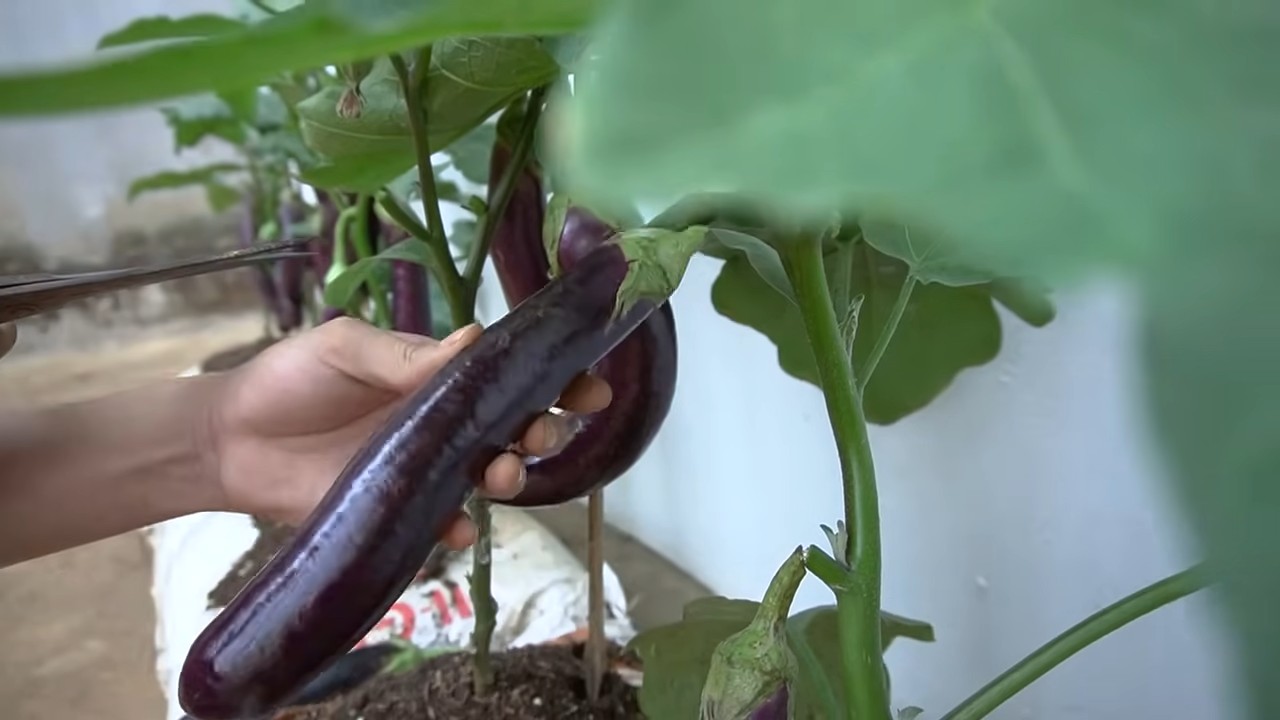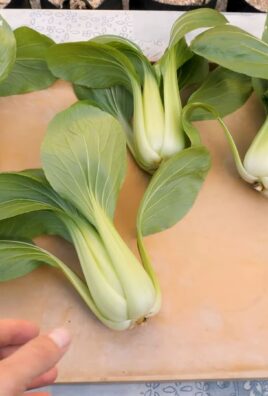Eggplant growing tips for beginners can feel overwhelming, right? I remember when I first started, I felt like I was battling every bug and disease imaginable! But trust me, with a few simple tricks and DIY hacks, you can be harvesting beautiful, glossy eggplants in no time.
Eggplants, also known as aubergines, have a rich history, originating in India and making their way across the globe. They’ve been cultivated for centuries, and different cultures have developed unique ways to nurture these fascinating plants. From the Mediterranean’s moussaka to Asia’s stir-fries, eggplants are a culinary staple. But growing them yourself? That’s where the real magic happens!
Why do you need these DIY tricks? Because store-bought eggplants just don’t compare to the flavor and satisfaction of growing your own. Plus, you control everything – from the soil to the pest control – ensuring you’re eating healthy, organic produce. This article is packed with easy-to-follow eggplant growing tips for beginners, designed to help you avoid common pitfalls and maximize your harvest. We’ll cover everything from seed starting to pest control, so you can confidently grow your own delicious eggplants, even if you’ve never gardened before. Let’s get started!

Growing Eggplants: Your Beginner-Friendly Guide for a Bountiful Harvest
Hey garden friends! Eggplants, those shiny, purple beauties, can be a fantastic addition to your vegetable garden. Many beginners shy away from them, thinking eggplants are difficult to grow. But don’t worry, with a few simple tricks and some patience, you too can bring in a bountiful harvest. I’ll show you how!
What You Need Before You Start:
Before we dive into the details, here’s a little checklist to make sure you have everything ready:
- Eggplant seeds or young plants (I recommend starting with young plants if you have little experience)
- Seed starting mix (for sowing)
- Pots or seed trays
- Garden soil (well-draining and nutrient-rich)
- Compost or organic fertilizer
- Plant stakes (to support the plants)
- Watering can or garden hose
- Mulch material (e.g., straw or wood chips)
- Patience and love!
The Preparation: The Key to Success
Preparation is everything when it comes to growing eggplants. Here are the most important steps:
- Choosing the right variety: There are countless eggplant varieties, from the classic purple ones to white, green, or even striped ones. Find out which varieties grow well in your region and which ones you like the taste of best. Popular varieties for beginners include ‘Black Beauty’, ‘Ichiban’, and ‘Listada de Gandia’.
- The right location: Eggplants love the sun! Choose a location that receives at least 6-8 hours of direct sunlight per day. The soil should be well-draining and rich in nutrients. Avoid locations where water tends to pool.
- Preparing the soil: Loosen the soil thoroughly and remove stones and weeds. Work in plenty of compost or organic fertilizer to enrich the soil with nutrients. Eggplants are heavy feeders and require a good supply of nutrients.
Seeds or Young Plants?
You have a choice: either you start your eggplants from seed yourself, or you buy young plants from a garden center. Both options have their pros and cons.
- Sowing: Sowing is more cost-effective, and you have a wider selection of varieties. However, it is also more time-consuming and requires a bit more experience. Eggplants have a long growing season and should ideally be started indoors 8-10 weeks before the last frost.
- Young plants: Young plants are easier to handle and save time. However, they are more expensive, and the selection of varieties is limited. When buying young plants, make sure they look healthy and strong and show no signs of diseases or pests.
Sowing in Detail (if you choose this option):
- Choosing the right time: Start sowing about 8-10 weeks before the last frost in your region.
- Preparing the seeds: Soak the eggplant seeds in lukewarm water for 24 hours. This speeds up germination.
- Sowing in seed starting mix: Fill seed trays or small pots with seed starting mix. Press the soil down lightly and sow the seeds about 1 cm deep.
- Keep moist: Water the soil gently and keep it moist, but not wet.
- Keep warm: Place the seed trays in a warm place (24-27°C). A heating mat can help speed up germination.
- Light: Once the seeds have germinated, the seedlings need a lot of light. Place them on a bright windowsill or use a plant lamp.
- Pricking out: When the seedlings have 2-3 true leaves, you will prick them out into larger pots.
Planting Out: Finally Outdoors!
Once the danger of frost has passed and the soil temperature is at least 15°C, the eggplants can be planted outdoors.
- Hardening off: Before you plant the eggplants out, you should harden them off for a few days. Place them outdoors for a few hours during the day and bring them back in at night. This helps them get used to the new conditions.
- Planting distance: Plant the eggplants 45-60 cm apart.
- Preparing the planting hole: Dig a hole that is slightly larger than the plant’s root ball.
- Planting: Carefully place the eggplants in the hole and fill it with soil. Press the soil down lightly.
- Watering in: Water the plants thoroughly.
- Mulching: Cover the soil around the plants with mulch material. This helps to retain moisture in the soil, suppress weeds, and keep the soil warm.
The Care: Keeping Your Eggplants Thriving
Proper care is crucial for a bountiful harvest. Here are the most important points:
- Watering: Eggplants need regular water, especially during flowering and fruit formation. It’s best to water them in the morning so the leaves can dry during the day. Avoid waterlogging.
- Fertilizing: Fertilize the eggplants every 2-3 weeks with an organic fertilizer or compost tea.
- Staking: Eggplant plants can collapse under the weight of the fruit. Support them with plant stakes or a trellis.
- Pinching out: Regularly remove side shoots that grow from the leaf axils. This encourages the formation of fruit.
- Pests and diseases: Watch out for pests like aphids, Colorado potato beetles, and spider mites. If necessary, combat them with natural remedies like neem oil or a soap solution. Eggplants can also be affected by fungal diseases like powdery mildew. Ensure good ventilation and avoid wetting the leaves when watering.
The Harvest: The Reward for Your Effort
Harvest time is the best part! Eggplants are ready to be picked when they have reached their full color and feel firm. The skin should be shiny and plump.
- The right time: Harvest the eggplants before they become overripe. Overripe eggplants become bitter and spongy.
- Cutting: Cut the eggplants with a sharp knife or pruning shears. Leave a small stem on the fruit.
- Storage: Eggplants do not keep for long. Store them in the refrigerator and use them within a few days.
Common Problems and Solutions:
- Flowers fall off: This can have various causes, e.g., temperatures that are too high or too low, lack of water, or nutrient deficiency. Ensure optimal conditions and fertilize the plants regularly.
- Fruits don’t get big: This can be due to a lack of water, nutrient deficiency, or too little sun. Provide enough water, fertilizer, and a sunny location.
- Pests: Check the plants regularly for pests and combat them with natural remedies if necessary.
Additional Tips for a Successful Eggplant Harvest:
Practice crop rotation: Do not plant eggplants in the same spot every year. Rotate the location to prevent diseases and pests.

Conclusion
So, there you have it! Mastering the art of growing your own eggplants doesn’t have to be an intimidating endeavor. By implementing these simple yet effective DIY tricks, even the most novice gardener can cultivate a thriving eggplant patch and reap the rewards of fresh, flavorful produce. We’ve covered everything from seed starting and soil preparation to pest control and harvesting, providing you with a comprehensive guide to success.
The beauty of these techniques lies in their accessibility and adaptability. You don’t need fancy equipment or specialized knowledge to get started. With a little patience, dedication, and the right approach, you can transform your backyard into an eggplant paradise.
Why is this a must-try? Because growing your own eggplants offers a multitude of benefits. First and foremost, you gain access to incredibly fresh and flavorful eggplants that far surpass anything you can find in a grocery store. The taste difference is truly remarkable, especially when you harvest them at their peak ripeness. Secondly, you have complete control over the growing process, ensuring that your eggplants are free from harmful pesticides and chemicals. This is particularly important for those who prioritize organic and sustainable gardening practices. Finally, growing your own food is an incredibly rewarding experience. There’s a unique sense of satisfaction that comes from nurturing a plant from seed to harvest and then enjoying the fruits (or in this case, vegetables) of your labor.
Consider these variations to personalize your eggplant growing journey:
* **Container Gardening:** If you have limited space, don’t despair! Eggplants thrive in containers, making them perfect for balconies, patios, or small gardens. Choose a large pot (at least 5 gallons) and use a high-quality potting mix.
* **Grafting:** For increased disease resistance and vigor, explore the option of grafting your eggplant seedlings onto a more robust rootstock. This technique is particularly beneficial in areas with challenging soil conditions or prevalent soilborne diseases.
* **Companion Planting:** Enhance your eggplant’s growth and deter pests by planting beneficial companion plants nearby. Basil, marigolds, and thyme are excellent choices.
* **Different Varieties:** Don’t limit yourself to the standard globe eggplant. Experiment with different varieties, such as Japanese eggplants (long and slender), Italian eggplants (smaller and sweeter), or Thai eggplants (small and round). Each variety offers a unique flavor and texture.
We strongly encourage you to give these **eggplant growing tips for beginners** a try. Start small, be patient, and don’t be afraid to experiment. The journey of growing your own food is a learning process, and every season brings new opportunities for growth and discovery.
Once you’ve harvested your first batch of homegrown eggplants, we’d love to hear about your experience! Share your successes, challenges, and any tips you’ve learned along the way in the comments section below. Let’s create a community of eggplant enthusiasts and inspire others to embark on their own gardening adventures. Happy growing!
Frequently Asked Questions (FAQ)
What is the best time to start eggplant seeds indoors?
The ideal time to start eggplant seeds indoors is typically 6-8 weeks before the last expected frost in your area. This allows the seedlings to develop a strong root system before being transplanted outdoors. Check your local frost dates to determine the appropriate timing for your region. Starting seeds indoors gives them a head start, especially in areas with shorter growing seasons.
What type of soil is best for growing eggplants?
Eggplants thrive in well-drained, fertile soil that is rich in organic matter. The ideal soil pH is between 6.0 and 7.0. Before planting, amend your soil with compost, aged manure, or other organic amendments to improve its fertility and drainage. Avoid heavy clay soils, as they can become waterlogged and hinder root growth. If you have clay soil, consider growing your eggplants in raised beds or containers.
How often should I water my eggplants?
Eggplants require consistent moisture, especially during hot weather. Water deeply and regularly, aiming to keep the soil consistently moist but not waterlogged. Check the soil moisture level regularly by sticking your finger into the soil. If the top inch feels dry, it’s time to water. Avoid overhead watering, as this can increase the risk of fungal diseases. Drip irrigation or soaker hoses are excellent options for delivering water directly to the roots.
How do I protect my eggplants from pests and diseases?
Eggplants are susceptible to various pests and diseases, including flea beetles, aphids, spider mites, and fungal diseases like early blight and verticillium wilt. To protect your plants, implement a combination of preventative measures and targeted treatments. Use row covers to protect young seedlings from pests. Regularly inspect your plants for signs of infestation or disease. Remove any affected leaves or plants promptly. Consider using organic pest control methods, such as insecticidal soap or neem oil, to control pests. Ensure good air circulation around your plants to prevent fungal diseases. Crop rotation can also help to reduce the buildup of soilborne diseases.
When is the best time to harvest eggplants?
Eggplants are typically ready to harvest 65-80 days after transplanting, depending on the variety. The best time to harvest is when the fruit is glossy, firm, and has reached its mature size but before the skin becomes dull or the seeds become too large. Gently press the skin of the eggplant. If it springs back slightly, it’s ready to harvest. Use a sharp knife or pruning shears to cut the eggplant from the plant, leaving a short stem attached. Overripe eggplants can become bitter and seedy.
Can I grow eggplants in containers?
Yes, eggplants can be successfully grown in containers, making them a great option for gardeners with limited space. Choose a large container (at least 5 gallons) with drainage holes. Use a high-quality potting mix that is well-draining and rich in nutrients. Water regularly and fertilize every 2-3 weeks with a balanced fertilizer. Place the container in a sunny location that receives at least 6-8 hours of sunlight per day. Container-grown eggplants may require more frequent watering and fertilization than those grown in the ground.
What are some common problems when growing eggplants and how can I fix them?
Some common problems include blossom drop (flowers falling off without producing fruit), stunted growth, and pest infestations. Blossom drop can be caused by temperature extremes, insufficient pollination, or nutrient deficiencies. Ensure your plants receive adequate sunlight and water. Hand-pollinate the flowers if necessary. Fertilize with a balanced fertilizer to provide essential nutrients. Stunted growth can be caused by poor soil conditions, lack of nutrients, or pest infestations. Amend your soil with compost or other organic matter. Fertilize regularly and control pests promptly.
Are there any specific varieties of eggplant that are easier for beginners to grow?
Yes, some varieties are known for being more beginner-friendly. ‘Black Beauty’ is a classic globe eggplant that is relatively easy to grow and produces abundant yields. ‘Ichiban’ is a Japanese eggplant that is also known for its ease of cultivation and delicious flavor. ‘Little Fingers’ is a smaller variety that is well-suited for container gardening. When choosing a variety, consider your local climate and growing conditions.
How do I encourage more fruit production on my eggplant plants?
To encourage more fruit production, ensure your plants receive adequate sunlight, water, and nutrients. Prune your plants to remove suckers (small shoots that grow from the base of the plant) and any yellowing or diseased leaves. This will help to improve air circulation and direct the plant’s energy towards fruit production. Hand-pollinate the flowers if necessary. Fertilize regularly with a balanced fertilizer that is rich in phosphorus and potassium.
Can I save seeds from my eggplants to plant next year?
Yes, you can save seeds from your eggplants, but keep in mind that the resulting plants may not be true to type, especially if you grew multiple varieties of eggplants in the same area. To save seeds, allow the fruit to fully ripen on the plant until it becomes soft and dull. Cut the eggplant open and scoop out the seeds. Rinse the seeds thoroughly to remove any pulp. Spread the seeds out on a paper towel to dry completely. Store the dried seeds in an airtight container in a cool, dark, and dry place.




Leave a Comment